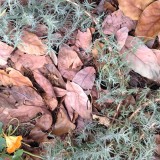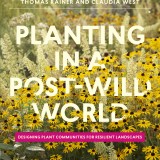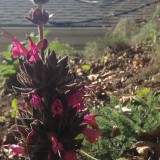I was standing in our friend David’s back yard, talking with him about the difficulties of re-designing your garden. One of them is removing trees and shrubs, not because of the physical labor–though that is considerable–but because of the psychic cost.
David shrugged and said, “I don’t know–when they get to be as tall as me, and I go to take them out, it feels like murder.”
I agree with him. It’s hard. One of the old rules of gardening is that you can’t be afraid to be ruthless in achieving your vision, but one of the realities of gardening is that most of us are not ruthless and often live with less than ideal situations because we don’t want to make those changes. Or we make the changes, but feel bad as we do it.
This dynamic is interesting, because we are told by our culture that we can do whatever we want to nature, because nature is just a pile of insensate matter for us to work our will upon. Fine. But it doesn’t always feel that way, does it? Oh, well…that’s just because we’re foolish and sentimental. Right?
I don’t think so at all.
We should be respectful when the time comes to make changes in your garden. There’s nothing wrong with making changes–the trick is in how they’re made, and why.
When you remove a plant and it’s the right thing to do, and it’s done properly, it feels good. Really good. Not just on an aesthetic or practical level, but on a gut level.
You don’t miss the plant once its gone. The empty space is hardly noticeable. The garden feels more lively or, conversely, more peaceful. It’s as if energy which was blocked by that ailing or misplaced plant is now flowing again. It’s an almost physical sensation–like a fresh breeze blowing through your yard.
But when a plant, especially a tree, is removed in a thoughtless or untimely way, though, it feels like a wound. The empty space looks haunted. The wrongness is deep, and it takes a long time to fade.
There are places in my landscape (both in my own yard or my stomping grounds) which are haunted by the ghosts of plants lost. I have to turn my face aside as I walk by.
So how do you know the difference? Well, here’s the subtle part. I’ve finally figured out that it’s not a matter of right and wrong so much as it’s about how.
Nature destroys. Death is part of life. Plants come and go in the wild and they can come and go in your yard. But when they go, they should go for good reason, and you should be clear about that reason in your head.
Some decisions are easier than others. Plants which are struggling are sending you a message. If you can’t help them by simple means–like jiggering their water or applying compost– then let them go. Stop fighting the inevitable just because you have a preconceived idea that your perfect yard has to have a peach tree or roses or whatever. Or worse, that you paid good money for a plant and you’re not going to let it die. Release the stunted and the disease-prone and the perpetually wilted. They were not meant to grow there.
If you made a design mistake, such as planting a tree too close to a foundation, or planting two shrubs too close together, so now they’re crowding one another and making a sort of Frankenstein hedge, you have to correct it. Gardening has a huge learning curve. You’re going to make mistakes. It’s inevitable. You have to fix the problem.
If the plant in question is thriving, full of rude health, not poorly placed but not fitting into your future plans, meditate on that. A thriving plant–the kind that doesn’t seem to need any care at all–is a blessing in any yard. Can you work with it somehow?
If you can’t, that’s okay. It’s just respectful to acknowledge and reflect on the fact that it is a strong plant growing in a location well suited to its needs. It may be in the wrong place at this time, but you can learn from this mistake, and come to know that particular species better. You may also gain insight into what types of plants like the conditions in your garden.
When you’ve made your decision, whether the plant is healthy or ill, go out into the garden and have a talk, both with the garden as a whole and with the individual plant or plants you are going to remove.
(You may feel silly doing this, but you know, KonMari would have you do this with your socks and old mobile phones and IMHO it’s a heck of a lot less silly to do this with plants than with your household clutter.)
Speak from your heart. Don’t be embarrassed. Explain your vision, addressing the entire garden as a totality. It is made up of many different layers of life, and all of them will be effected by what you do. Explain that you are working on a plan which will bring more life and beauty to your little corner of the world and serve the greater good. Doing this might clarify things in your own head a bit, too.
Thank the specific plants which you will be removing for all they have done, for their beauty, for their fruit, their shade, for the homes they’ve given the birds–whatever you have witnessed.
Apologize for what you have to do, acknowledge the seriousness of the act, but don’t feel guilty. Instead, feel the rightness of it. Plants understand community and the greater good. We’re the ones who need schooling on that front. If you’re acting with good intent, they’ll understand.
If it feels right to you, you could make a little thanks offering. For instance, you could put out seed for birds, as a token gift to the garden as a whole. You could take a Native American tact and offer a pinch of a dried, sacred plant. You could burn incense. You could send up a prayer of thanksgiving. You could invoke St. Francis. Your intention matters more than the specific action–you are giving thanks.
If you do these things, you’ll find that when you take up your clippers, axe or saw, you’ll feel a lot better. You’ll be working with the flow of your garden, not against it. The work will go easier, and you’ll end the day feeling that you’ve done well.
Remember, your yard wants to thrive. It wants to be beautiful and it wants to work with you to make that happen. Trust in that. Be your garden’s respectful partner, not its petty emperor.







It’s rough. When we moved into our new place in Oakland, we couldn’t figure out how to keep a single plant – not the fruit trees neglected for years nor the landscaping plants installed a few weeks ago by the flippers (date palms planted inches apart and tiny, struggling azaleas).
Our yard is so tiny (less than .1 acre) that we couldn’t afford to be sentimental – everything had to go before we could even make our solar map to figure out plant placement.
The avocado removal was more like a mercy killing – the poor thing had been folded, stapled and mutilated – but valiantly bearing a single blossom.
We found plenty of evidence of previous murder attempts upon the plum tree – the tree was actually sucker growth.
I always encourage gardeners to be ruthless in removing plants they don’t want – unwanted trees will go untended and untreated, becoming a vector for disease for the whole neighborhood. And who is going to take the time to take care of that lemon trees if you hate citrus fruits?
what a great and timely post. I have lived here in my midwestern rural home for 18 years, and I can’t remember when I planted my dwarf sour cherry, but I have really cherished it. I love the stippled bark, the stocky trunk, the flowers in spring, the wonderful, obscenely healthy fruit in late June. I typically stand near it in the early evening, picking the fruit and eating it in the heat of the day. This fall, suddenly, I noticed that the bark on the western side of my tree had split and was peeling. Frost cracking? where the western sun warms the trunk and causes it to swell a bit. Whatever the cause, I am not sure yet whether I will leave my beloved tree until next year to see how it will do. The trunk is not girdled, but of course like all living things, trees have life spans, and maybe my dwarf has reached the end of its span.
Beautiful post, thank you 🙂
What a wonderful post! We recently had to take out two, nearly dead, 100 year old spruce. It was hard, and it took us four years to get up the nerve, but when it was finally done, I did even notice. My husband did it quickly while I was away and as I drove in, I felt my yard looked somehow refreshed, but couldn’t put my finger on it. My husband had a laugh and we walked out to where he hauled the two old trees, and it was amazing how small they looked. I’ve seen healthy trees taken down, and they look huge! A massive protest lying there in an unnatural state. But these two went quietly, and it looked as though maybe we had picked up a few fallen branches. No regrets there. But it was still important for us to acknowledge them.
Thank you for the wonderful post!
I feel guilty about the beautiful maple tree we removed from our front yard. It was unfortunately just three feet too close to the house – You could see a tree-shaped shadow in the moss and lichen stricken and rotting roofing shingles. The roof has been since re-done, but there was also not overlooking the rising crack in the front walkway. Looking back, we could have just been more diligent about keeping the roof leaf-free, or removed the walkway, trimmed back the root, and put in a better looking walkway (brick perhaps, not the boring concrete). Unfortunately we made the quick decision it had to go because we have *so* many house projects, it seems like adding tasks or figuring out a solution to keeping the tree was just an unwanted one. What made me want to buy the house in the first place was seeing a google street map view with this lovely tree in fall color. The tangled and ugly mess of a holly tree in the back yard though, dont’ miss it. Or the giant non-native silk tree that would’ve shadowed the entire yard (and continued making a very large mess of the roof). We love planting, and light is critical in the Pacific North West. No regrets for those two trees. But I definitely miss that maple.
What a lovely post. You have described exactly how I felt when I cut down a beautiful Tulip Tree.
It’s a native tree in our area and I grew it from a seedling in a dixie cup, and up potted it for the first 5 years.
We just have a backyard, large but not large enough for a 100′ tree, I planted it anyway.
When our neighbour took down a huge maple in her yard and I could now see the 100′ tree in another yard I realised what I had done.
It was just too tall, I waited a year, agonizing about it and I know it was the right thing to do but it was hard.
I talked to my tree and apologized for what we had to do.
Thank you for putting into words, my feelings. I think my tree understood, at least I hope it did.
Absolutely spot-on. So glad to know I’m not alone in this!
Very profound. I am proud to call myself a (literal) “tree hugger” and although I cannot get my arms all the way around my Green Ash tree, have been known to embrace it and say “You’re a good tree, Big Al” – don’t ask me why I call it Al, haven’t a clue 🙂 But it may be inevitable that the Emerald Ash Borer makes its way to my suburban Denver lot one day and it will break my heart. I am not treating it because of the effect on the bees, which may lead to an earlier demise. But if love can help it stave off the disease, then that’s what I can do. Thank you Kelly.
Tanya
Very profound. Thank you. I am so glad to know there are others who feel as I do. When I moved here the yard was just an acre of dirt. Now I have trees, shrubs and flowers that the bees, butterflies, and wildlife enjoy. It is my sanctuary.
We took down one of our 88ft Douglas fir tree’s that was too close to our house and was starting too look like a Charley Brown tree. It was so heart wrenching. I agree with the blog that when I apologized to the tree and thanked it for being so wonderful to us, it definitely released something in me that made it feel better to bring her down. I also kept the bark dust and wood to use in my garden and wood stove so her memory continues.
Pingback: Our new front yard: history | Root Simple